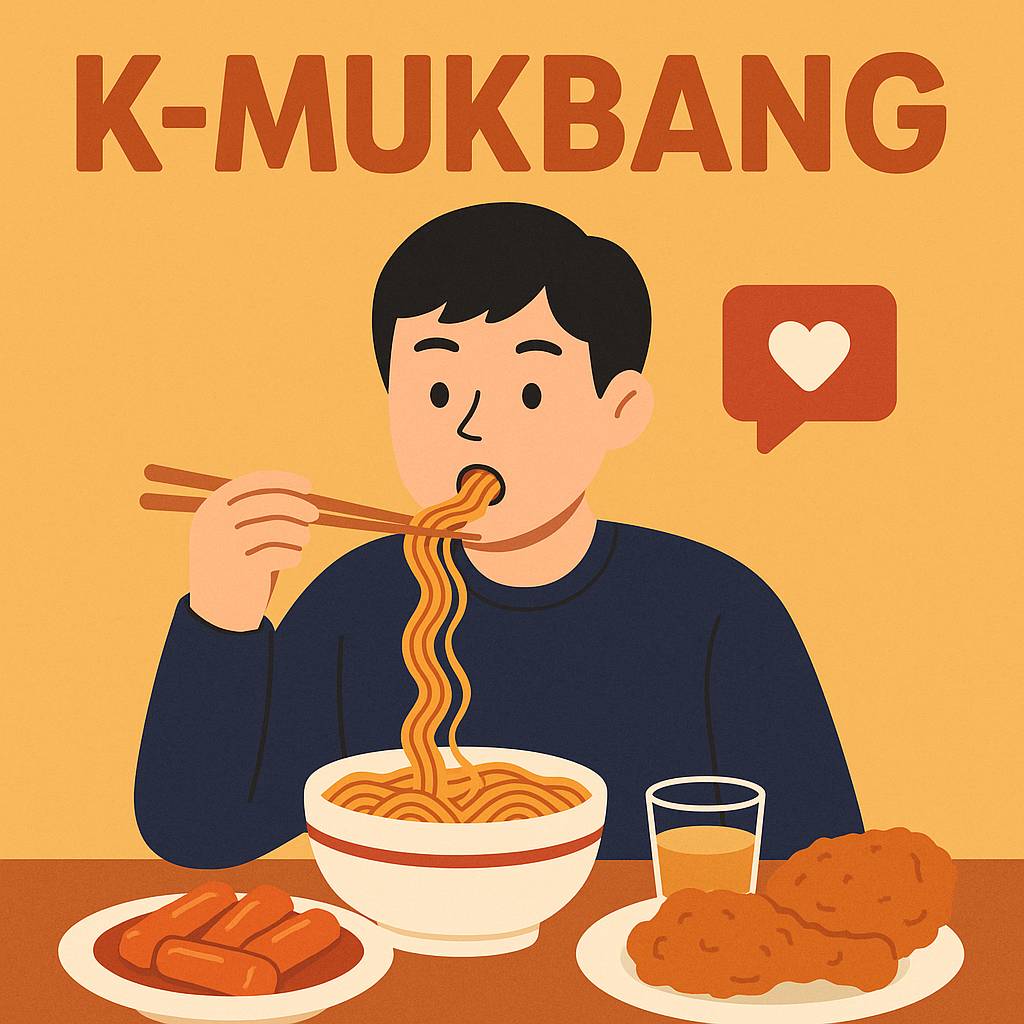Introduction: What Is K-Mukbang?
The term “Mukbang (먹방)” is a Korean portmanteau of “muk-da” (먹다: to eat) and “bang-song” (방송: broadcast). In short, it means “eating broadcast.” A person eats large quantities of food on camera, usually while interacting with a live audience.
Originally born in South Korea in the early 2010s, K-Mukbang has since exploded in popularity both domestically and globally. It’s now a full-blown digital entertainment genre on platforms like YouTube, AfreecaTV, TikTok, and Twitch. Millions of viewers tune in from all over the world.
Why Do People Watch Mukbang?
At first glance, watching someone eat might sound strange. But mukbangs are more than just food—they’re about connection, comfort, and culture.
1. Vicarious Satisfaction
Many viewers say they feel satisfied just by watching someone eat delicious food. This is especially true if they are dieting or living alone. The visual and auditory elements—the crunch of fried chicken, the slurp of noodles—provide sensory pleasure.
2. Parasocial Relationships
Mukbang creators often talk directly to viewers, creating a friendly, intimate atmosphere. For many, it’s like eating with a friend or comforting presence, reducing feelings of loneliness.
3. ASMR Appeal
Many mukbangs are designed to trigger ASMR (autonomous sensory meridian response). The crispy, juicy, and slurping sounds are deeply satisfying for many viewers, creating a sense of relaxation.
4. Cultural Exploration
K-Mukbang introduces global audiences to Korean food culture. It showcases street foods like tteokbokki and hotteok. It also features home dishes like kimchi jjigae and samgyeopsal. It serves as an accessible gateway into K-culture.
The Evolution of K-Mukbang
1. From Webcams to Studios
Early mukbangs were raw and unscripted, often streamed live from small rooms using simple webcams. Today, top K-mukbangers have professional setups, sponsorship deals, and millions of subscribers.
2. Diversified Content
Not all mukbangs are about overeating. Sub-genres include:
- Mini mukbangs with modest portions
- Healthy mukbangs with vegan or fitness-friendly meals
- Cooking + Eating where creators first prepare the meal, then eat
- Silent mukbangs focusing purely on food and ASMR
3. Collaborations and Crossovers
K-Mukbang stars now collaborate with K-pop idols, chefs, and vloggers, expanding their reach. Some even appear on Korean variety shows or publish cookbooks.
Famous K-Mukbangers
- Banzz (밴쯔): One of Korea’s original mukbang pioneers, known for massive portion sizes and clean eating style.
- Tzuyang (쯔양): A young female mukbanger famous for her quiet demeanor and enormous eating capacity.
- Hamzy (햄지): Known for traditional Korean dishes, beautiful plating, and soothing ASMR.
- Dorothy (도로시): Gained global attention with spicy mukbang challenges.
These creators aren’t just YouTubers—they’re influencers, entrepreneurs, and cultural ambassadors.
The Cultural Significance of K-Mukbang
Mukbang is more than entertainment—it reflects deeper aspects of Korean society:
– Solo Eating Culture
As single-person households rise in Korea, solo dining has become more common. Mukbang offers a virtual mealtime companion, fulfilling emotional needs.
– Work and Stress
Koreans work long hours, and cooking or eating with others isn’t always possible. Watching someone else enjoy food becomes a form of emotional release or healing.
– Food-Centered Identity
In Korean culture, food is tied to memory, family, and care. Mukbang celebrates this relationship by showcasing food as more than sustenance—it’s emotion, heritage, and story.
Global Expansion and Influence
K-Mukbang has influenced creators around the world, leading to:
- International Mukbang Creators in the U.S., Japan, China, Southeast Asia, and more
- Cross-cultural fusion food mukbangs
- Brand sponsorships from both Korean and global food companies
- Translation captions, subtitles, and even multilingual hosts to reach wider audiences
Korean mukbang paved the way for a global digital food movement, integrating K-culture into everyday online entertainment.
Health Concerns and Criticisms
Despite its popularity, mukbang faces ethical and health-related criticisms:
- Overeating and Waste: Some criticize creators for promoting binge eating or wasting food.
- Disordered Eating: There’s concern that mukbang may glorify unhealthy relationships with food.
- Monetization Pressure: Creators may feel pushed to increase their food intake or take on risky eating challenges to gain views.
In response, many K-mukbang stars are now promoting balance—focusing on nutrition, smaller portions, or behind-the-scenes exercise routines to maintain health.
Final Thoughts: Why We’ll Keep Watching
K-Mukbang taps into universal human needs—the joy of food, the comfort of companionship, and the curiosity about culture. It offers a low-barrier way to explore Korean cuisine, meet new personalities, and unwind.
As it continues to evolve, K-Mukbang is likely to become more interactive. It will also become more health-conscious and culturally expansive. This evolution paves the way for the next generation of food-based digital storytelling.
You might be watching to relax. Or you could be learning about kimchi. Perhaps you’re just listening to the crunch of perfectly fried chicken. K-Mukbang offers a feast for the senses—and the soul.
